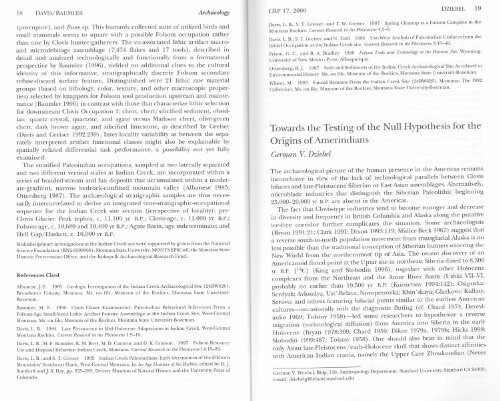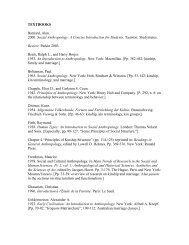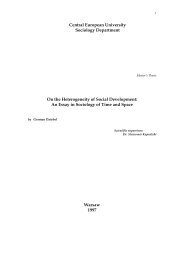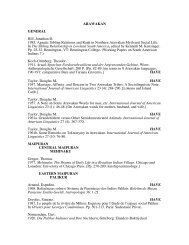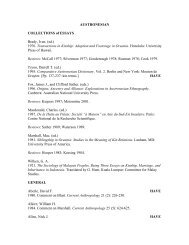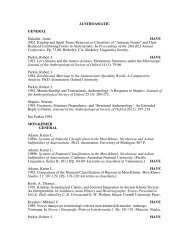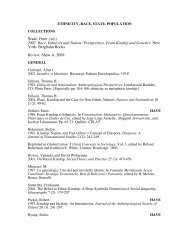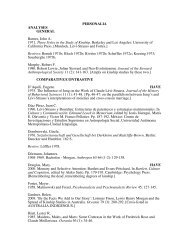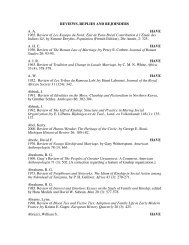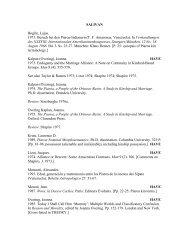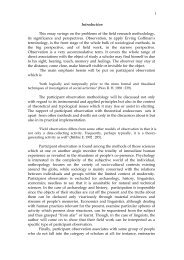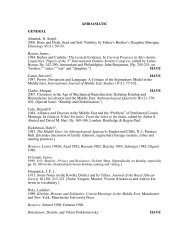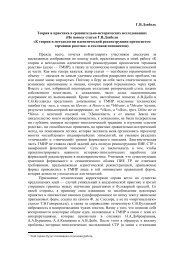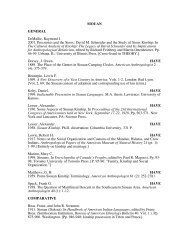Towards the Testing of the Null Hypothesis for the ... - Kinship Studies
Towards the Testing of the Null Hypothesis for the ... - Kinship Studies
Towards the Testing of the Null Hypothesis for the ... - Kinship Studies
You also want an ePaper? Increase the reach of your titles
YUMPU automatically turns print PDFs into web optimized ePapers that Google loves.
18 DAVIS/BAUMLER ArchaeologyCRP 17, 2000DZIEBEL 19(porcupine), and Bison sp. This humanly collected suite <strong>of</strong> utilized birds andsmall mammals seems to square with a possible Folsom occupation ra<strong>the</strong>rthan one by Clovis hunter-ga<strong>the</strong>rers. The co-associated lithic artifact macroandmicrodebitage assemblage (7,474 flakes and 17 tools), described indetail and analyzed technologically and functionally from a <strong>for</strong>mationalperspective by Baumler (1996), yielded no additional clues to <strong>the</strong> culturalidentity <strong>of</strong> this in<strong>for</strong>mative, stratigraphically discrete Folsom secondaryrefuse-discard surface feature. Distinguished were 21 lithic raw materialgroups (based on lithology, color, texture, and o<strong>the</strong>r macroscopic properties)selected by knappers <strong>for</strong> Folsom tool production upstream and maintenance(Baumler 1996) in contrast with those that characterize lithic selection<strong>for</strong> downstream Clovis Occupation 1: chert, chert/silicified sediment, obsidian,quartz crystal, quartzite, and agate versus Madison chert, olive-greenchert, dark brown agate, and silicified limestone, as described by Greiser(Davis and Greiser 1992:239). Inter-locality variability as between <strong>the</strong> separatelyinterpreted artifact functional classes might also be eXplainable byspatially related differential task per<strong>for</strong>mance, a possibility not yet fullyexamined.The stratified Paleoindian occupations, sampled at two laterally separatedand two different vertical scales at Indian Creek, are incorporated within aseries <strong>of</strong> braided-stream and fan deposits that accumulated within a moderate-gradient,narrow bedrock-confined mountain valley (Albanese 1985;Ottersberg 1987). The archaeological stratigraphic samples are thus necessarilyintercorrelated to derive an integrated time-stratigraphic-occupationalsequence <strong>for</strong> <strong>the</strong> Indian Creek site section (irrespective <strong>of</strong> locality): pre-Clovis Glacier Peak tephra, c. 11,100 yr B.P.; Clovis-age, c. 11,000 yr B.P.;Folsom-age, c. 10,680 and 10,400 yr B.P.; Agate Basin, age indeterminate; andHell Gap/Haskett, c. 10,000 yr B.P.Multidisciplinary investigations at <strong>the</strong> Indian Creek site were supported by grants from <strong>the</strong> NationalScience Foundation (BNS-8508068), Montana State University, MONTS EPSCoR, <strong>the</strong> Montana StateHistoric Preservation Otllce, and <strong>the</strong> Kokopelli Archaeological Research Fund.'ReferencesCitedAlbanese,]. F. 1985 Geologic Investigation <strong>of</strong> <strong>the</strong> Indian Creek Archaeological Site (24BW626),Broadwater County, Montana. Ms. on file, Museum <strong>of</strong> <strong>the</strong> Rockies, Montana State University-Bozeman.Baumler, M. F. 1996 Upon Closer Examination: Paleoindian Behavioral Inferences From aFolsom-Age Small-Sized Lithic Artifact Feature Assemblage at <strong>the</strong> Indian Creek Site, West-CentralMontana. Ms. on file, Museum <strong>of</strong> <strong>the</strong> Rockies, Montana State University-Bozeman.Davis, L. B. 1984 Late Pleistocene to Mid-Holocene Adaptations at Indian Creek, West-CentralMontana Rockies. CurrentResearchin <strong>the</strong> Pleistocene1:9-10.Davis, L. B., M. F. Baumler, K. M. Bovy, M. D. Cannon, and D. K. Grayson 1997 Folsom ResourceUse and Disposal Behavior: Indian Creek, Montana. Current Researchin <strong>the</strong>Pleistocene14:18-20.Davis, L. B., and S. T. Greiser 1992 Indian Creek Paleoindians: Early Occupation <strong>of</strong> <strong>the</strong> ElkhornMountains' Sou<strong>the</strong>ast Flank, West-Central Montana. In Ice Age Hunters <strong>of</strong> <strong>the</strong> Rockies, edited by D.].Stan<strong>for</strong>d and]. S. Day, pp. 225-283. Denver Museum <strong>of</strong> Natural History and <strong>the</strong> University Press <strong>of</strong>Colorado.Davis, L. B., S. T. Greiser, and T. W. Greiser 1987 Spring Cleanup at a Folsom Campsite in <strong>the</strong>Montana Rockies. Current REsearchin <strong>the</strong> Pleistocene4:5-6.Davis, L. B., S. T. Greiser, and N. Toth 1985 Use-Wear Analysis <strong>of</strong> Paleo indian Unifaces from <strong>the</strong>Initial Occupation at <strong>the</strong> Indian Creek site. CurrentResearchin <strong>the</strong> Pleistocene2:45-46.Frison, G. C., and B. A. Bradley 1980 Folsom Tools and Technology at <strong>the</strong> Hanson Site, Wyoming.University <strong>of</strong> New Mexico Press, Albuquerque.Ottersberg, R.]. 1987 Soils and Sediments <strong>of</strong> <strong>the</strong> Indian Creek Archaeological Site As related toEnvironmental History. Ms. on file, Museum <strong>of</strong> <strong>the</strong> Rockies, Montana State University-Bozeman.Wilson, M. 1985 Faunal Remains From <strong>the</strong> Indian Creek Site (24BW626), Montana: The 1982Collection. Ms. on file, Museum <strong>of</strong> <strong>the</strong> Rockies, Montana State University-Bozeman.<strong>Towards</strong> <strong>the</strong> <strong>Testing</strong> <strong>of</strong> <strong>the</strong> <strong>Null</strong> Hypo<strong>the</strong>sisOrigins <strong>of</strong> AmerindiansGerman V DziebeZ<strong>for</strong> <strong>the</strong>The archaeological picture <strong>of</strong> <strong>the</strong> human presence in <strong>the</strong> Americas remainsinconclusive in view <strong>of</strong> <strong>the</strong> lack <strong>of</strong> technological parallels between Clovisbifaces and late-Pleistocene Siberian or East Asian assemblages. Alternatively,microblade industries that distinguish <strong>the</strong> Siberian Paleolithic beginning23,000-20,000 yr B.P. are absent in <strong>the</strong> Americas.The fact that Clovis-type industries tend to become younger and decreasein diversity and frequency in British Columbia and Alaska along <strong>the</strong> putativeice-free corridor fur<strong>the</strong>r complicates <strong>the</strong> situation. Some archaeologists(Bryan 1991:21; Clark 1991; Dixon 1993:119; Muller-Beck 1967) suggest thata reverse south-to-north population movement from transglacial Alaska is noless possible than <strong>the</strong> traditional conception <strong>of</strong> ~iberian hunters entering <strong>the</strong>New World from <strong>the</strong> nor<strong>the</strong>rnmost tip <strong>of</strong> Asia. The recent discovery <strong>of</strong> anAmericanoid fluted point at <strong>the</strong> Uptar site in nor<strong>the</strong>ast Siberia dated to 8,300yr B.P. [l4C] (King and Slobodin 1996), toge<strong>the</strong>r with o<strong>the</strong>r Holocenecomplexes from <strong>the</strong> Nor<strong>the</strong>ast and <strong>the</strong> Amur River Basin (Ushki VII-VI,probably no earlier than 10,500 yr B.P. (Kuznetsov 1994:142); Osipovka;Serdyak; Avlondya, Ust'-Belaya; Novopetrovka; Khin'skaya; Glazkovo; Kullaty;Serovo; and o<strong>the</strong>rs featuring bifacial points similar to <strong>the</strong> earliest Americancultures-occasionally with <strong>the</strong> diagnostic fluting (d. Chard 1974; Derevianko1969; Tolstoy 1958)-led some researchers to hypo<strong>the</strong>size a reversemigration (technological diffusion) from America into Siberia in <strong>the</strong> earlyHolocene (Bryan 1978:309; Chard 1959; Dikov 1979a, 1979b; Hicks 1998;Slob odin 1999:487; Tolstoy 1958). One should also bear in mind that <strong>the</strong>only Asian late-Pleistocene/ early-Holocene skull that shows distinct affinitieswith American Indian crania, namely <strong>the</strong> Upper Cave Zhoukoudian (NevesGerman V. Dziebel, Bldg. 110, Anthropology Department, Stan<strong>for</strong>d University, Stan<strong>for</strong>d CA 94305;e-mail: dziebelg@leland.stan<strong>for</strong>d.edu
20 DZIEBELDZIEBEL 21Archaeology CRP 17, 2000and Pucciarelli 1998), is probably younger (10,600 yr B.P.) (Kamminga 1992)than Clovis.The emerging startling controversy in American archaeology is <strong>the</strong>re<strong>for</strong>ethat <strong>the</strong> Clovis culture long believed to have originated in <strong>the</strong> New World(Krieger 1964:55) shows not a population expansion from Asia but a migrationfrom America into Asia across <strong>the</strong> Bering bridge. Paradoxically, <strong>the</strong> ClovisFirst paradigm is in need <strong>of</strong> pre-Clovis sites in order to demonstrate archaeologicallythat America was actually peoPled from <strong>the</strong> Old World.The lack <strong>of</strong> reliable archaeological sites in pre-14,000 yr B.P. America isconsistent not only with <strong>the</strong> lack <strong>of</strong> human occupation but equally with smallpopulation size, isolation, and certain patterns <strong>of</strong> mobility among <strong>the</strong> earliestAmericans. A single archaeological site in a region occupied by small isolateddemes would be as important as a series <strong>of</strong> sites left by a rapidly growing orstable large population. Alternatively, <strong>the</strong> paucity <strong>of</strong> lithics in <strong>the</strong> Americanarchaeological record is consistent not only with <strong>the</strong> lack <strong>of</strong> human presencebut equally with a pattern <strong>of</strong> economic adaptation marginal in <strong>the</strong> Old WorldPleistocene, namely, <strong>the</strong> one that lays emphasis on perishables (bone, wood,bark) on <strong>the</strong> one hand, and "s<strong>of</strong>t" practices (<strong>for</strong>aging, trapping, driving) on<strong>the</strong> o<strong>the</strong>r. Thus <strong>the</strong> sudden proliferation <strong>of</strong> sites throughout <strong>the</strong> Americasaround 12,000 yr B.P. may represent "<strong>the</strong> upper part <strong>of</strong> a sigmoid curve, with<strong>the</strong> base <strong>of</strong> <strong>the</strong> curve lying well back in <strong>the</strong> middle Pleistocene" (Gruhn1997:30). The recent acceptance <strong>of</strong> Monte Verde II raises <strong>the</strong> probability thato<strong>the</strong>r pre-Clovis sites such as Cactus Hill (16,000-15,000 yr B.P.), Meadowcr<strong>of</strong>tRockshelter Stratum II (15,000-13,000 yr B.P.), Pendejo Cave (25,000-12,000 yr B.P.), Monte Verde 1(33,000 yr B.P.), Pedra Furada (40,000 yr B.P.)indeed mark <strong>the</strong> presence <strong>of</strong> early inhabitants in <strong>the</strong> Americas.The belief that humans colonized <strong>the</strong> Americas from Asia penetratedEuropean consciousness well be<strong>for</strong>e science could give it any empirical or<strong>the</strong>oretical support. Since <strong>the</strong>n <strong>the</strong> accumulation <strong>of</strong> data has been orientedtowards making <strong>the</strong> evidence compatible with this assumption; as a result, <strong>the</strong>null hypo<strong>the</strong>sis has never been adequately tested. For <strong>the</strong> history <strong>of</strong> anygeographically distinct region, <strong>the</strong> null hypo<strong>the</strong>sis boils down to <strong>the</strong> assumptionthat its population is not derivative <strong>of</strong> any o<strong>the</strong>r population. The lack <strong>of</strong>conclusive evidence <strong>for</strong> <strong>the</strong> peopling <strong>of</strong> <strong>the</strong> Americas from any Old Worldlocation is coupled with continuing uncertainty about <strong>the</strong> origins <strong>of</strong> livinghumans in <strong>the</strong> Old World (Smith and Harold 1997) to <strong>the</strong> effect that <strong>the</strong>discussion <strong>of</strong> <strong>the</strong> origins <strong>of</strong> Amerindians should be more sensitive to <strong>the</strong>necessity <strong>of</strong> noncontroversial rejecting <strong>of</strong> <strong>the</strong> null hypo<strong>the</strong>sis <strong>for</strong> this continent.It seems that Pleistocene archaeology can greatly benefit from adopting<strong>the</strong> long-standing and well-supported tradition in population genetics(Chakraborty and Weiss 1991; Neel 1970; Ward 1997) to treat Amerindiansas exemplary <strong>of</strong> <strong>the</strong> earliest human adaptive condition.- 1991 The Fluted-point Tradition in <strong>the</strong> Americas - One <strong>of</strong> Several Adaptations to LatePleistocene American Environments. In Clovis: Origins and Adaptations, R. Bonnichsen and K. L.Turnmire editors, Center <strong>for</strong> <strong>the</strong> Study <strong>of</strong> <strong>the</strong> First Americans.Chakraborty, R. and K. M. Weiss 1991 Genetic Variation <strong>of</strong> <strong>the</strong> Mitochondrial DNA Genome inAmerican Indians Is at Mutation Drift Equilibrium. AmericanJournal <strong>of</strong>PhysicalAnthropology86:497-506.Chard, Chester S. 1959 New World Origins: a Reappraisal. Antiquity, 33(29):44-49. .- 1974 Nor<strong>the</strong>astAsia in Prehistory.Madison: University <strong>of</strong> Wisconsin Press.Clark, D. W. 1991 The Nor<strong>the</strong>rn (Alaska-Yukon) Fluted Points. In Clovis: Originsand Adaptations.R. Bonnichsen and K. L. Turnmire, editors, Center <strong>for</strong> <strong>the</strong> Study <strong>of</strong> <strong>the</strong> First Americans.Derevianko, A. P. 1969 The Novopetrovka Blade Culture on <strong>the</strong> Middle Amur. Arctic Anthropology6(1):119-127.Dikov, N. N. 1979a Ancient Cultures <strong>of</strong> Nor<strong>the</strong>asternAsia. Nauka, Moscow.- 1979b Cultural Relations Between Nor<strong>the</strong>ast Asia and America Based on Late Pleistoceneand Early Holocene Sites in Ramchatka, Chukotka and <strong>the</strong> Upper Reaches <strong>of</strong> <strong>the</strong> Kolyma. Papers<strong>of</strong><strong>the</strong> XIV Pacific ScienceCongress,Khabarovsk, August 1979. Vol. 2, pp. 191-193. Moscow.Dixon, E.]. 1993 Quest <strong>for</strong> <strong>the</strong> Origins <strong>of</strong> <strong>the</strong> First Americans. University <strong>of</strong> New Mexico Press,Albuquerque.Gruhn, R. 1997 The South American Context <strong>of</strong> <strong>the</strong> Pedra Pintada Site in Brazil. CurrentResearchin <strong>the</strong> Pleistocene,'14:29-32.Hicks, A. M. 1998 Alternative Explanation <strong>for</strong> Similarities Between Native Americans and Siberians,Human Biology,70(1):137-140.Kamminga,]. 1992 New Interpretations <strong>of</strong> <strong>the</strong> Upper Cave Zhoukoudian. In The Evolution andDispersal <strong>of</strong> Modern Humans in Asia. T. Akazawa, K. Aoki, T. Kimura, editors. Hokusen-sha. Tokyo.King, M. L. and S. B. Slobodin 1996 A Fluted Point from <strong>the</strong> Uptar Site, Nor<strong>the</strong>astern SiberiaScience,273 (5275) :634-636.Krieger, A. D. 1964 Early Man in <strong>the</strong> New World In PrehistoricMan in <strong>the</strong>New World.]. D. ] enningsand E. Norbeck, editors. University <strong>of</strong> Chicago Press.Kuznetsov, A. M. 1994 Paleolithic <strong>of</strong> <strong>the</strong> Russian Far East: A Geoarchaeological Aspect <strong>of</strong> <strong>the</strong>Problem. Current Researchin Pleistocene11:140-143. .Miiller-Beck, H.:/. 1967 Migrations <strong>of</strong> Hunters on <strong>the</strong> land bridge in <strong>the</strong> Upper Pleistocene InThe Bering Land Bridge. D. M. Hopkins, editor, pp. 373-408. Stan<strong>for</strong>d University Press.Ned,]. V. 1970 Lessons from a "Primitive People". Science170(3960) :815-822.Neves, W. and H. Pucciarelli 1998 The Zhoukoudian Upper Cave Skull 101 as Seen from <strong>the</strong>Americas. Journal afHuman Evolution 34(2) :219-222.Smith, S. L. and F. B. Harrold 1997 A Paradigm's Worth <strong>of</strong> Difference? Understanding <strong>the</strong>Impasse over Modern Human Origins. Yearbook<strong>of</strong> PhysicalAnthrapology 40:113-138.Tolstoy, P. 1958 The Archaeology <strong>of</strong> <strong>the</strong> Lena Basin and its New World relationships, part IIAmerican Antiquity 24(1)63-81.Ward, R. 1997 Phylogeography <strong>of</strong> Human mtDNA: An Amerindian Perspective. In ProgressinPopulation Genetics and Human Evolution. P. Donelly and S. Tavare, editors. pp. 33-53. Springer-Verlag. New York.ReferencesCitedBryan, A. L. 1978 An Overview <strong>of</strong> Paleo-American Prehistory from a Circum-pacific PerspectiveIn Early Man in America From a Circum-PacificPerspective.Archaeological Researches International,Edmonton.
CURRENTRESEARCHIN THE PLEISTOCENEVolume 17 2000EditorBradley T. LepperOhio Historical Society, Columbus, OhioDirector & General EditorRobson BonnichsenCenter <strong>for</strong> <strong>the</strong> Study <strong>of</strong> <strong>the</strong> First Americans,Oregon State UniversityAssistant EditorAliceHallCenter <strong>for</strong> <strong>the</strong> Study <strong>of</strong> <strong>the</strong> First Americans,Oregon State UniversityAssociateEditorsDaniel FisherMuseum <strong>of</strong> Paleontology, University <strong>of</strong> MichiganLinda ShaneLimnological Research Center, University <strong>of</strong> MinnesotaThomas Staf<strong>for</strong>d, Jr.Staf<strong>for</strong>d Research Laboratories Inc., Boulder, ColoradoRoberta HallDepartment <strong>of</strong> Anthropology, Oregon State UniversityA Peopling <strong>of</strong> <strong>the</strong> Americas PublicationCenter <strong>for</strong> <strong>the</strong> Study <strong>of</strong> <strong>the</strong> First AmericansOregon State UniversityCorvall is, Oregon


